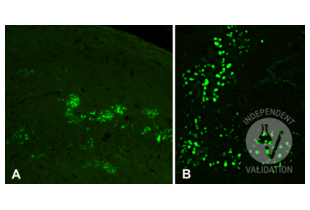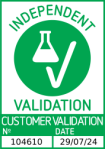5-Methylcytosine Antikörper
-
- Target
- 5-Methylcytosine
- Reaktivität
- Bitte anfragen
-
Wirt
- Kaninchen
-
Klonalität
- Polyklonal
-
Konjugat
- Unkonjugiert
-
Applikation
- Western Blotting (WB), Flow Cytometry (FACS), Immunofluorescence (Paraffin-embedded Sections) (IF (p)), Immunohistochemistry (Paraffin-embedded Sections) (IHC (p))
- Kreuzreaktivität
- Human
- Kreuzreaktivität (Details)
- 5 MethylCytosine
- Aufreinigung
- Purified by Protein A.
- Immunogen
- KLH conjugated 5 MethylCytosine
- Isotyp
- IgG
-
-
- Applikationshinweise
-
IHC-P 1:100-500
IF(IHC-P) 1:50-200 - Beschränkungen
- Nur für Forschungszwecke einsetzbar
-
- by
- Prof. Merighi, Laboratory of Neurobiology, Department of Veterinary Sciences, University of Turin
- No.
- #104610
- Datum
- 29.07.2024
- Antigen
- 5-Methylcytosine
- Chargennummer
- 9K04V1
- Validierte Anwendung
- Immunohistochemistry
- Positivkontrolle
Adult (> 2 months) CD1 mouse brain fixed in 4% paraformaldehyde.
- Negativkontrolle
One control slice for each experimental procedure processed omitting the primary antibody; overnight incubation in diluent solution only.
- Bewertung
Passed. The antibody works for IHC-P at 1:100 and 1:200 concentrations without microwave antigen retrieval
- Primärantikörper
- ABIN1385081
- Sekundärantikörper
- Full Protocol
- Perfuse mice with paraformaldehyde 4% in 0.1 M phosphate buffer pH 7.4 and post-fix of samples in the same fixative for an additional 2 h at RT.
- Wash, dehydrate, and embed samples in paraffin wax.
- Wash several times with 0.01 M PBS.
- Cut the brain with a microtome into 6 µm sections and mount them on glass slides.
- After paraffin removal, sections were incubated for 1 hour at room temperature in PBS containing 1% albumin from chicken egg white (Sigma, A5378) and 0.3% Triton-X-100 (BioRad, 161-0407, lot # 00583) to block non-specific binding sites.
- Incubate sections with the primary antibody anti-5-methyl-cytosine (ABIN1385081; Lot 9K04V1) at 1:50, 1:100, and 1:200 in PBS-BSA-(Sigma, A7906)- PLL (Sigma, P1524) at RT in a humid chamber.
- Wash sections 3x 5 min with 0.01 M PBS.
- Incubate sections with anti-rabbit secondary antibody Alexa Fluor 488, 1:500, in 0.1M PBS (Thermo Fisher Scientific, A11034, lot # 2380031) for 1 h at RT.
- Wash sections 3x 5 min with 0.01 M PBS.
- Specimens were mounted in Fluoroshield (Sigma, F6182, lot # MKCB0153V).
- Images were acquired with a Leica DM 6000B fluorescence microscope with a digital camera at 40x magnification.
- Anmerkungen
Validierung #104610 (Immunohistochemistry)![Erfolgreich validiert 'Independent Validation' Siegel]()
![Erfolgreich validiert 'Independent Validation' Siegel]() Validierungsbilder
Validierungsbilder![5-methyl-cytosine immunoreactive neuronal nuclei in the mouse forebrain. A: a group of immunoreactive nuclei in the deep layers of the cerebral cortex (original magnification 20x); B: at higher magnification (40x), the positive 5-methyl-cytosine sites are visible in the form of a punctate reaction. Primary antibody dilution: 1:100. No microwave.]() 5-methyl-cytosine immunoreactive neuronal nuclei in the mouse forebrain. A: a group of immunoreactive nuclei in the deep layers of the cerebral cortex (original magnification 20x); B: at higher magnification (40x), the positive 5-methyl-cytosine sites are visible in the form of a punctate reaction. Primary antibody dilution: 1:100. No microwave.
Protokoll
5-methyl-cytosine immunoreactive neuronal nuclei in the mouse forebrain. A: a group of immunoreactive nuclei in the deep layers of the cerebral cortex (original magnification 20x); B: at higher magnification (40x), the positive 5-methyl-cytosine sites are visible in the form of a punctate reaction. Primary antibody dilution: 1:100. No microwave.
Protokoll -
- Format
- Liquid
- Konzentration
- 1 μg/μL
- Buffer
- 0.01M TBS( pH 7.4) with 1 % BSA, 0.02 % Proclin300 and 50 % Glycerol.
- Konservierungsmittel
- Sodium azide
- Vorsichtsmaßnahmen
- This product contains Sodium azide: a POISONOUS AND HAZARDOUS SUBSTANCE, which should be handled by trained staff only.
- Lagerung
- 4 °C,-20 °C
- Informationen zur Lagerung
- Shipped at 4°C. Store at -20°C for one year. Avoid repeated freeze/thaw cycles.
- Haltbarkeit
- 12 months
-
- Target
- 5-Methylcytosine
- Andere Bezeichnung
- 5 MethylCytosine
- Substanzklasse
- Chemical
- Hintergrund
-
Synonyms: 5-Methyl Cytidine, 5 m C, 5 mC, 5 me C, 5 Me Cytidine, 5 MeCyd, 5 Methyl Cytidine, 5 MethylCytosine, 5-mC, 5-Me Cytidine, 5-Methyl-Cytosine, 5-MethylCytidine.
Background: Cytidine is a nucleoside formed by a cytosine attached to a ribose ring via a beta-N1-glycosidic bond. DNA is methylated on cytidines by DNA methylases (DNMTs)to generate 5-methylcytidine (5-mC), a potent epigenetics marker and regulator of gene expression. The reverse reaction (cytidine demethylation) starts with its oxidation to hydroxymethyl- (5-hmC), formyl- (5-fC), and carboxy- (5-caC) cytidine. Several enzymes, including the Tet family of proteins have been implicated in cytidine demethylation.
-


 (1 Validierung)
(1 Validierung)



